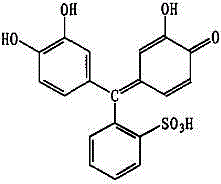Preparation method of heat-resistant composite magnetic material
A magnetic material and heat-resistant technology, which is applied to the magnetism of organic materials/organic magnetic materials, manufacturing of inductors/transformers/magnets, electrical components, etc., can solve problems such as ignoring heat resistance, achieve good curing effect, and improve overall performance , High heat resistance effect
- Summary
- Abstract
- Description
- Claims
- Application Information
AI Technical Summary
Problems solved by technology
Method used
Image
Examples
Embodiment 1
[0021] Embodiment 1 A method for preparing a heat-resistant composite magnetic material, comprising the following steps:
[0022] (1) Disperse 300g of nano-silica foam in deionized water, then add 100g of dodecylbenzenesulfonic acid and 400g of bismuth nitrate pentahydrate; then hydrothermally react at 150°C for 10 hours; then filter the reaction solution to obtain a solid powder; then mix the solid powder with 1Kg ferric oxide, and ball mill for 1 hour to obtain the mixture; use phthalate as binder, press the mixture into tablets; then calcined at 850°C for 3 hours; then in a nitrogen atmosphere sintering at 1250°C for 5 hours, and after natural cooling, crush the obtained solid to obtain a filler with a particle size of 1.8 to 2.5 microns;
[0023] (2) Mix 5g of phenolic compound and 100g of bisphenol A cyanate monomer, stir at 90°C for 20 minutes, add 2g of methylene tetrahydrobiphenyl dicarboxylic anhydride, and continue stirring for 10 minutes; then add 19g of pentaerythr...
Embodiment 2
[0025] Embodiment 2 A method for preparing a heat-resistant composite magnetic material, comprising the following steps:
[0026] (1) Disperse 300g of nano-silica foam in deionized water, then add 100g of dodecylbenzenesulfonic acid and 400g of bismuth nitrate pentahydrate; then hydrothermally react at 150°C for 10 hours; then filter the reaction solution to obtain a solid powder; then mix the solid powder with 1Kg ferric oxide, and ball mill for 1 hour to obtain the mixture; use phthalate as binder, press the mixture into tablets; then calcined at 850°C for 3 hours; then in a nitrogen atmosphere sintering at 1250°C for 5 hours, and after natural cooling, crush the obtained solid to obtain a filler with a particle size of 1.8 to 2.5 microns;
[0027] (2) Mix 5g of phenolic compound and 100g of bisphenol A cyanate monomer, stir at 90°C for 20 minutes, add 3g of methylenetetrahydrobiphenyl dicarboxylic anhydride, and continue stirring for 10 minutes; then add 19g of pentaerythri...
Embodiment 3
[0029] Embodiment 3 A method for preparing a heat-resistant composite magnetic material, comprising the following steps:
[0030] (1) Disperse 300g of nano-silica foam in deionized water, then add 100g of dodecylbenzenesulfonic acid and 400g of bismuth nitrate pentahydrate; then hydrothermally react at 150°C for 10 hours; then filter the reaction solution to obtain a solid powder; then mix the solid powder with 1Kg ferric oxide, and ball mill for 1 hour to obtain the mixture; use phthalate as binder, press the mixture into tablets; then calcined at 850°C for 3 hours; then in a nitrogen atmosphere sintering at 1250°C for 5 hours, and after natural cooling, crush the obtained solid to obtain a filler with a particle size of 1.8 to 2.5 microns;
[0031] (2) Mix 8g of phenolic compound and 100g of bisphenol A cyanate monomer, stir at 90°C for 20 minutes, add 2g of methylenetetrahydrobiphenyl dicarboxylic anhydride, and continue stirring for 10 minutes; then add 19g of pentaerythri...
PUM
| Property | Measurement | Unit |
|---|---|---|
| particle diameter | aaaaa | aaaaa |
Abstract
Description
Claims
Application Information
 Login to View More
Login to View More - R&D
- Intellectual Property
- Life Sciences
- Materials
- Tech Scout
- Unparalleled Data Quality
- Higher Quality Content
- 60% Fewer Hallucinations
Browse by: Latest US Patents, China's latest patents, Technical Efficacy Thesaurus, Application Domain, Technology Topic, Popular Technical Reports.
© 2025 PatSnap. All rights reserved.Legal|Privacy policy|Modern Slavery Act Transparency Statement|Sitemap|About US| Contact US: help@patsnap.com


